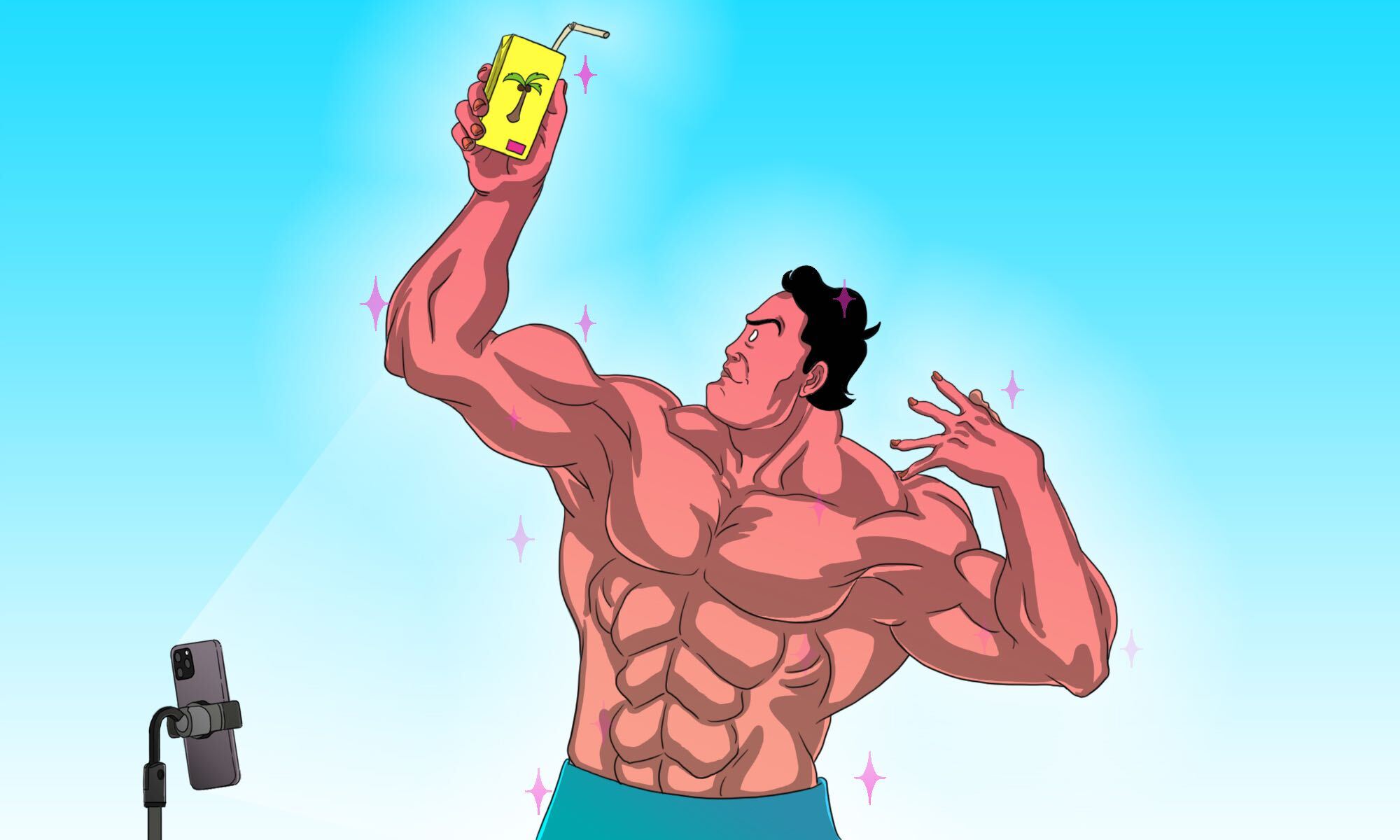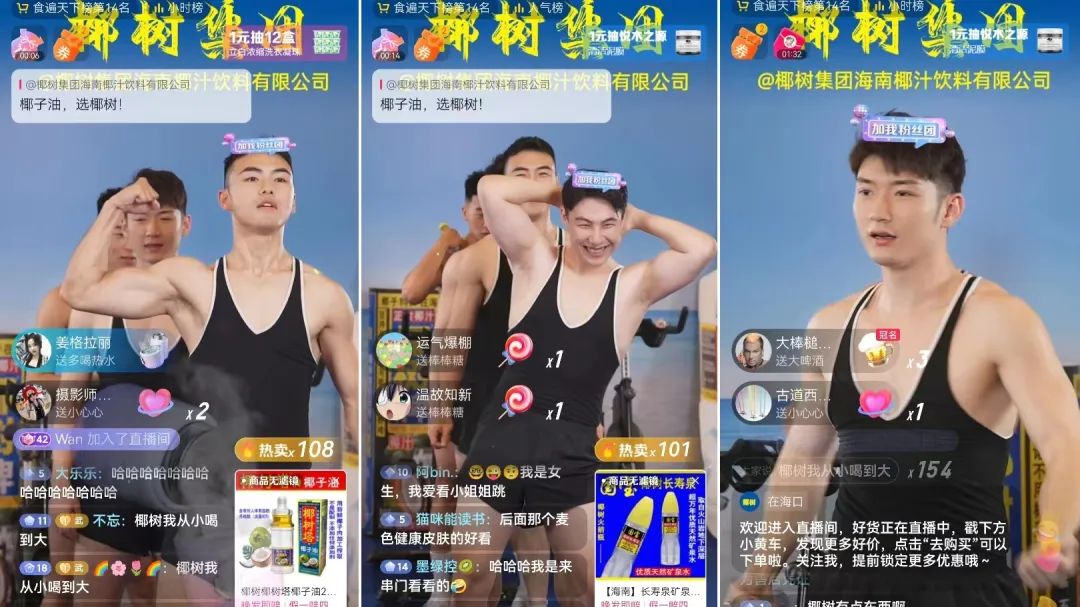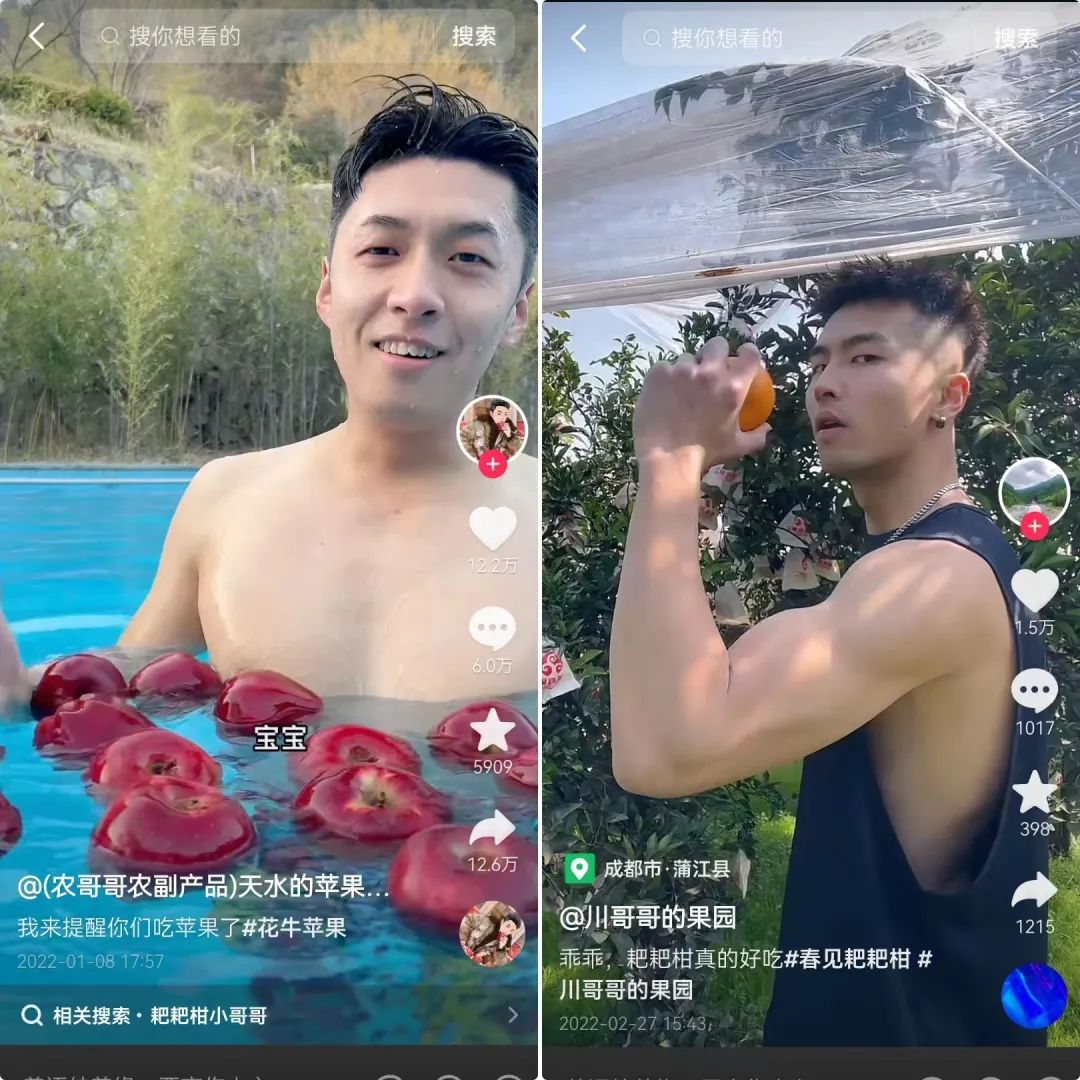Chinese brands turn to hunky heartthrobs
To target women consumers, Chinese brands are using hot male models in ecommerce livestreams, part of a larger trend, particularly in advertising, to subvert the male gaze. But is the strategy actually helping their sales?

Nothing makes a woman thirsty like a stable of gym rats sheepishly showing off their muscly thighs and popping biceps…right? At least, that’s what Coconut Palm (椰树牌 yēshù pái) would have you believe. In its recent livestreaming sales events, the Hainan-based beverage company has ramped up the use of hunky male models as salespeople — and they’re not alone.
“Hiring male celebrities to peddle products has been relatively common for the livestream industry,” Andy Crawford, a managing consultant from China Skinny, a Shanghai-based market research film, told The China Project. “But using unknown male models for consumer goods is fairly new and rising in use.”
Coconut Palm first employed beefy studs in a livestream on March 8, International Women’s Day. Viewers who tuned in saw a group of male models in tank tops and gym shorts, posing coyly with cans of coconut milk in their hands.

The livestream was an immediate hit, drawing a peak of 6.3 million viewers on Douyin (the Chinese version of TikTok). After the broadcast concluded, shocked internet users couldn’t stop sharing snippets of it on social media sites such as Weibo and Xiaohongshu, where a groundswell of commenters told the company to keep it up and even put forth suggestions for future livestreams.
In the weeks that followed, Coconut Palm offered a dozen livestream events with men as models, with the hosts often blatantly telling viewers to record or screenshot the performers (especially, for instance, while they were taking off their shirts). To increase engagement, the models also took requests from the audience. At one point, a scantily-clad guy shaved his leg. At another, a team of four agreed to divide up a three-piece suit, with the one getting the short end of the stick only getting to wear a vest with his boxers.
According to Chanmama, Douyin’s ecommerce data analysis platform, Coconut Palm’s livestreams in March attracted an average of 920,000 Douyin users who watched in real time, and a total of nearly 10 million views. Some of the models were also catapulted to internet fame, amassing thousands of followers for their individual accounts.
For Coconut Palm, this marks a pivot from an old strategy. For years, the company has been criticized for its advertising, including bogus claims about how its products can “benefit” female customers. In a 2019 ad, Coconut Palm cast a woman with large breasts holding a can of coconut milk in a white tank top. Next to her was the slogan, “A can a day and you’ll be pale and busty.” Its packaging that year featured a different woman in a form-fitting dress with this quote: “I grew up drinking it.”
The criticism in recent years has been led by young Chinese who are becoming more conscientious about the sexual objectification of women in media. The backlash even landed Coconut Palm in regulatory trouble, as it was fined in 2019 for false and vulgar advertising.
When it comes to ecommerce livestreams, Coconut Palm isn’t the only Chinese brand that has made a switch. Vinda, a major personal hygiene company from China, has hired several young male hosts for its Douyin livestreams this year. Although they often seem awkward when explaining the deals they are trying to promote, they smile a lot and call viewers affectionate nicknames.

Last November, Luckin Coffee, a local rival to Starbucks, livestreamed an all-male runway show on Douyin, with each model clutching a Luckin cup while showcasing designs by fashion students from a college in Zhejiang. The three-hour broadcast reportedly raked in upwards of a million viewers, more than double the average audience for its regular livestreams featuring female hosts.

“Cost and stagnation,” as explained by Crawford, are the two primary factors that influenced this trend from Chinese brands. “Average livestream costs have become astronomical recently for both female and male livestreamers. Marketers need to spread their budgets across multiple channels, so this is cost-effective for brands,” he said. “These smaller livestreamers, with their lower costs, reach a more niche and targeted audience than using the major stars.”
The financial constraints on advertising are particularly acute for small businesses, which have to be creative with their marketing strategies to stand out. On Douyin, there’s @农哥哥农副产品 (Farm brother’s agriculture products), whose entire feed is made up of clips of a tall, handsome orchard owner earnestly introducing his fruits to followers, sometimes at his plantation and sometimes in a swimming pool. “Good afternoon, babe. Please have an apple after your lunch,” reads the caption under a video of him sorting ripe fruits.
There’s also @川哥哥的果园 (Chuan brother’s orchard), a Douyin account owned by Dù Chuān杜川, a 22-year-old who operates a farm in Chengdu. With more than 270,000 followers, Du routinely films himself performing agricultural work while shelling his crops. Under a video of him harvesting oranges while shirtless, Du wrote, “These oranges are so juicy, my lovely ladies.”
Crawford suggested that these ads are designed to appeal to the people who actually do most of the purchasing in Chinese households — women. A 2021 report by JD.com, one of the biggest online retailers in China, revealed that 75 percent of all purchase decisions in Chinese families were made by women. According to global consultancy Accenture, there were nearly 400 million female consumers aged 20 to 60 in China in 2022, who controlled consumption expenditures of up to 10 trillion yuan ($1.45 trillion) annually.
“Women are often the lead purchase group and they have expressed being tired of seeing female influencers hawking products in livestreams, which has long been the norm for the ecommerce livestream industry,” Crawford said. “This shift to male livestreamers breaks up that long-time industry standard. These men are refreshing to the eye while still providing a sense of interest to viewers.”
“This isn’t to say this is only to target women, though,” he added. “These young men also provide a sense of inspiration to the larger male market as well.”
The emphasis on heartthrobs in ecommerce livestreams seems to be spurred by a significant cultural shift in Chinese society. On social media, there has been a growing awareness of and opposition against the “male gaze” (男凝 nánníng), the idea that everything women do is held up to the lens of what straight men want to see. Although the term was first conceptualized in 1975 by film critic Laura Mulvey and has been integral in feminist theory for decades, it didn’t enter the public lexicon in China until recent years, when the objectification of women — whether celebrities or ordinary women — was called out more frequently than ever.
In the meantime, the female gaze is celebrated as a form of women’s empowerment, a concept that has seen a surge of interest in the country. Against this backdrop, hunky men catering to women’s fantasies have been having a moment since last year. On Douyin, a trend dubbed “muscle memory theory” (肌肉记忆法 jīròu jìyì fǎ) has seen ripped, shirtless young men recording themselves superimposed over images of English words and their definitions. Under one of the most popular videos in this genre, which has attracted about 500,000 likes, the responses range from the goofy (“Can you be my English teacher? I promise I’ll be a good student!”) to the self-deprecating (“I’ve played this 300 times and I haven’t found the word I’m supposed to learn.”)
In livestreams of Coconut Palm and Vinda, similar remarks are regularly made toward the male models. But does this actually improve sales?
The answer, it turns out, is complicated.
According to Chanmama, a hunk-centric livestream event hosted by Coconut Palm typically rakes in sales of less than 50,000 yuan ($7,270), which is unimpressive compared to the amount of traffic it usually drives. “Coconut Palm’s use of muscular young men didn’t translate to sales because their viewers were not looking to buy just from good looks alone,” Crawford noted. “This marketing aimed to create buzz above sales.”
As evidenced by one comment on a Coconut Palm livestream in March, a Douyin user wrote, “Sisters, this is free entertainment. Just enjoy and don’t fall for these thirst traps!”







